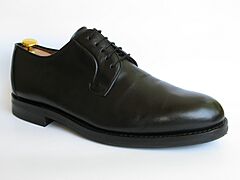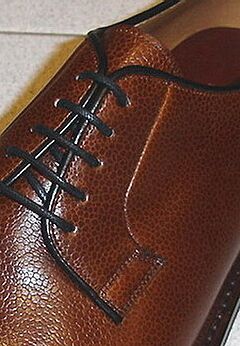Blucher shoe facts for kids
A blucher ( or Blücher) is a special kind of shoe known for its unique lacing style. It has what we call "open lacing." Imagine the part of the shoe that covers the top of your foot, called the vamp. In a blucher, this vamp is made from a single piece of leather. Small tabs with holes for your shoelaces are then sewn on top of this single piece.
Contents
What Makes a Blucher Shoe Special?
Blucher shoes are easy to spot because of their "open lacing." This means that when you tie your shoes, the parts with the eyelets (the holes for the laces) are not sewn directly under the front part of the shoe. Instead, they are sewn on top, allowing them to open up wider. This is different from "closed lacing," where the eyelets are hidden beneath the shoe's upper part, making it look smoother and more formal.
Blucher vs. Derby vs. Oxford: What's the Difference?
It can be a bit tricky to tell different shoe styles apart! Bluchers are often compared to derby shoes because both have open lacing. However, there's a key difference in how they are built.
- In a derby shoe, the main upper part of the shoe has larger sections, called "quarters," where the eyelets are sewn on top.
- In a blucher, the front part of the shoe (the vamp) is made from just one piece of leather. Only small tabs with the eyelets are sewn onto this single piece. This "one cut" design is a special feature of bluchers.
You might hear people in American English sometimes use "blucher" to mean a derby shoe, or even "Oxford" to mean a blucher. But now you know the specific details that make each style unique!
The Story Behind the Name
The blucher shoe has a fascinating history! It is named after a real person: Gebhard Leberecht von Blücher. He was a famous Field Marshal from Prussia (a powerful country in Europe long ago) in the 18th century.
How a Military Leader Inspired a Shoe Style
Field Marshal von Blücher wanted to make better boots for his soldiers. He asked for a new design where the side parts of the boot overlapped the front. This made the boots more comfortable and practical for his troops during long marches and battles. His idea worked so well that other armies across Europe soon started using similar designs for their soldiers' footwear. Over time, this military boot design evolved into the stylish blucher shoe we know today!
See also



